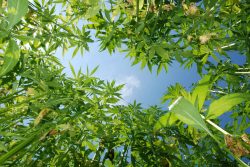
By Omar Sacirbey
It’s been more than two years since President Barack Obama signed legislation authorizing the limited cultivation of hemp, but the fledgling industry remains a long way from becoming a thriving business.
Observers say commercialization of this potentially lucrative plant remains limited for legal, financial and technological reasons.
They point to restrictive federal guidelines governing hemp, a dearth of investors willing to wager money on the plant, and a lack of commercial-scale processing equipment. Finding fixes to these challenges has proven difficult.
Hemp is used for various products, including CBD-based medicines as well as paper, clothing, food, lotions and supplements. It’s also used in industrial applications.
Much of the hemp used currently in the U.S., however, is imported.
Despite the glacial pace of hemp commercialization, advocates are bullish on the long-term prospects. They argue the 2014 Farm Bill – which authorized production for research purposes and a few select pilot programs – eventually will create opportunities for entrepreneurs.
“It’s a great time to be in the hemp industry,” Eric Steenstra, executive director of the California-based Hemp Industries Association, insisted. “For a long time we were importing and that’s finally starting to change with the breakthrough of hemp being included into the 2014 Farm Bill, even though it’s pretty limited.”
Before Farm Bill
While hemp cultivation was federally prohibited before the 2014 Farm Bill, hemp processing and products weren’t.
That’s why hemp food oils and textiles have been available for years.
The United States continues to import most of its hemp. Much of the hemp fiber comes from China and hemp food products from Canada, according to a 2015 Congressional Research Service report. The report valued hemp imports at about $40 million.
The Hemp Industries Association, along with the Hemp Business Journal, estimates the retail value of hemp products sold here in 2015 was “at least” $573 million. That includes hemp food, supplements and body care products as well as clothing and building materials, among other products.
Before the Farm Bill, 10 states had very limited hemp cultivation. Since the Farm Bill another 19 states have passed laws allowing hemp cultivation. But of the 29 states that have legalized hemp cultivation, only 12 have regulations that make commercialization possible, including seven states that adopted regulations recently and have just started or are starting commercial hemp growing.
The five states that did have commercially produced hemp last year accounted for about 5,000 acres between them, Steenstra estimated. The top two states by acreage are Kentucky and Colorado, he added.
In states without regulations, cultivation is done for scientific and medical research, as well as marketing- and economic-related research, such as studying how hemp growers can best sell their products or which varieties are well-suited for commercial applications.
While advocates tout hemp as a miracle plant, the few farmers growing hemp don’t have the equipment necessary to process hemp on an industrial scale for, say, paper or textile manufacturers.
Instead, hemp farmers must sell their product into a limited marketplace that, for now, is largely composed of CBD medicine makers and food processors.
“CBD is a huge market now. Food as well, like seed oil,” Courtney Moran, a hemp lobbyist and attorney at Earth Law LLC in Portland, Oregon, said.
Steenstra agreed: “We’re seeing some new activity that’s popping up. A lot of people have come in looking to produce cannabinoids, CBD predominantly, so we’re seeing farmers and companies connect pretty quickly.”
Lack of equipment
Perhaps the biggest impediment to the hemp industry tapping the paper and textiles industries is a lack of processing equipment, particularly decorticators which strip the softer outer bark from the woodier core of the plant known as hurd.
“We need harvesting and processing equipment to get us to that point,” Moran said.
The equipment is almost impossible to find in this country, because there hasn’t been a legal hemp industry that would necessitate decorticators. One of the few, and perhaps only, U.S. companies to have processing equipment is American Hemp in Winston Salem, North Carolina.
A “commercial hemp processing line is a substantial investment of millions of dollars,” Steenstra said.
The fiber separation technology that now exists is dated Steenstra added, but people here are trying to modernize such equipment.
“It’s a market opportunity for people to develop that kind of technology so we don’t have to keep importing everything,” Steenstra said.
But even those efforts have been slowed by the lack of capital behind the industry.
“We need solid investors to invest in the industry so we can invest in proper equipment,” Moran, the hemp lobbyist, said. “Once we have that the sky’s the limit.”
A new definition
One of the biggest challenges is educating lawmakers and the public that hemp and marijuana are different plants. Hemp advocates claim the current Drug Enforcement Administration marijuana definition incorrectly ensnares hemp.
The DEA defines marijuana as any cannabis sativa plant that contains THC. That includes hemp because it belongs to the cannabis sativa family and contains very small amounts of THC – well below levels that produce intoxication if consumed.
“The largest challenge is that hemp has been lumped in with marijuana over the last 70 years, and all of the constraints that come with that,” Paiss of the National Hemp Association said.
The DEA threshold is unnecessarily low and dated, some hemp advocates argue. In June, dozens of industry advocates asked the DEA to redefine marijuana to exclude hemp. They also want the agency to raise the THC threshold in hemp to 1%, West Virginia’s standard. Almost every state, by contrast, defines hemp as having less than 0.3% THC content.
But others don’t consider these changes urgent. Moreover, states have made changes. This year, for example, Virginia legalized industrial hemp cultivation and Oregon made it easier for farmers to get growing licenses.
“I think a lot of states are starting to recognize the economic opportunity that’s available to them,” Moran said.
Omar Sacirbey can be reached at omars@mjbizmedia.com

